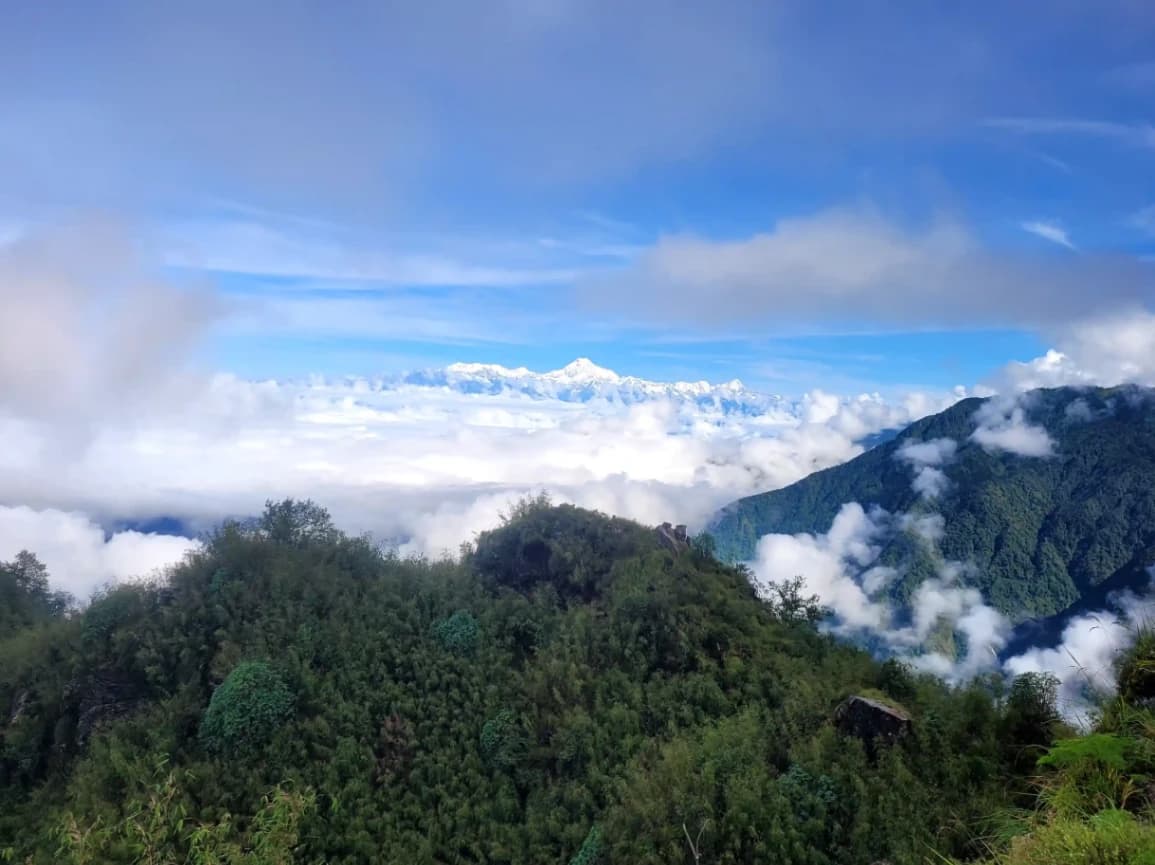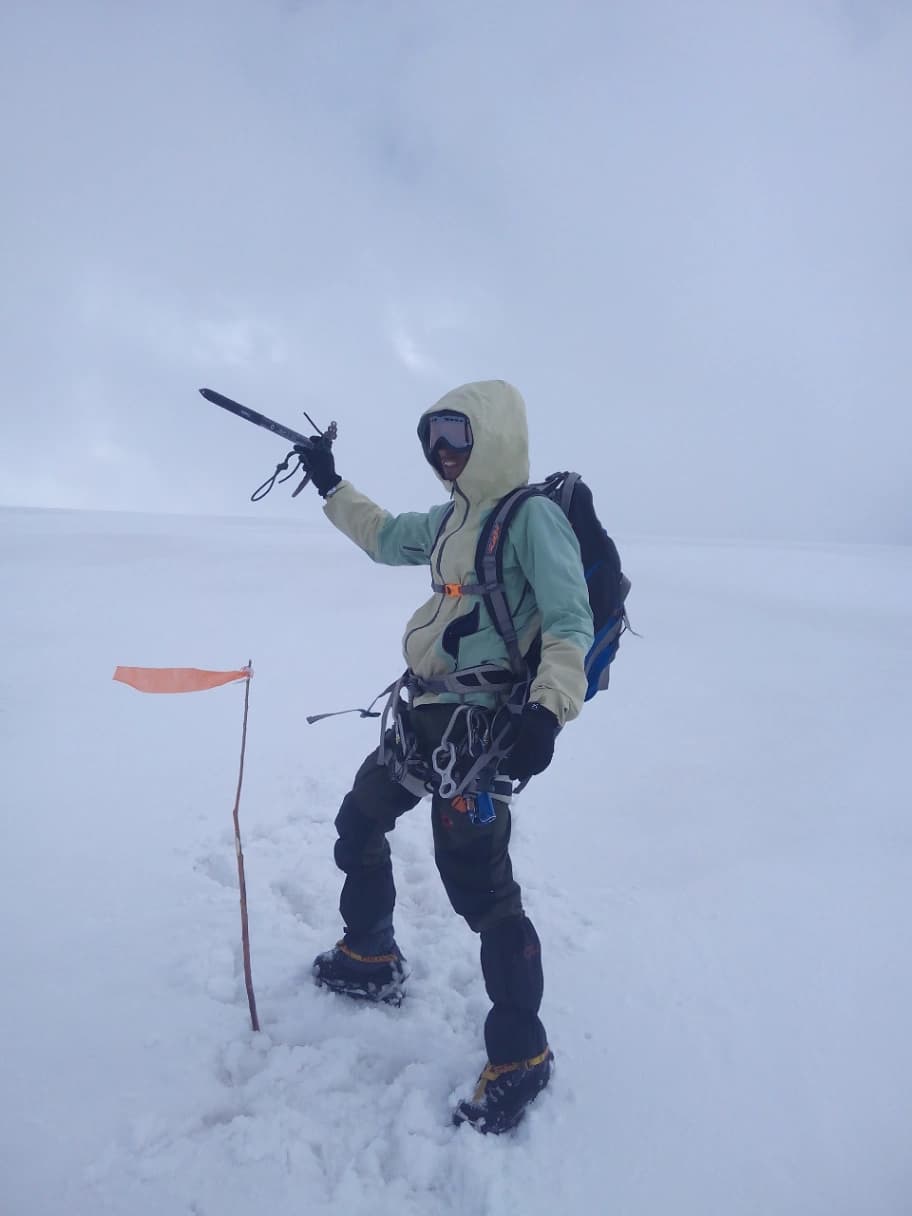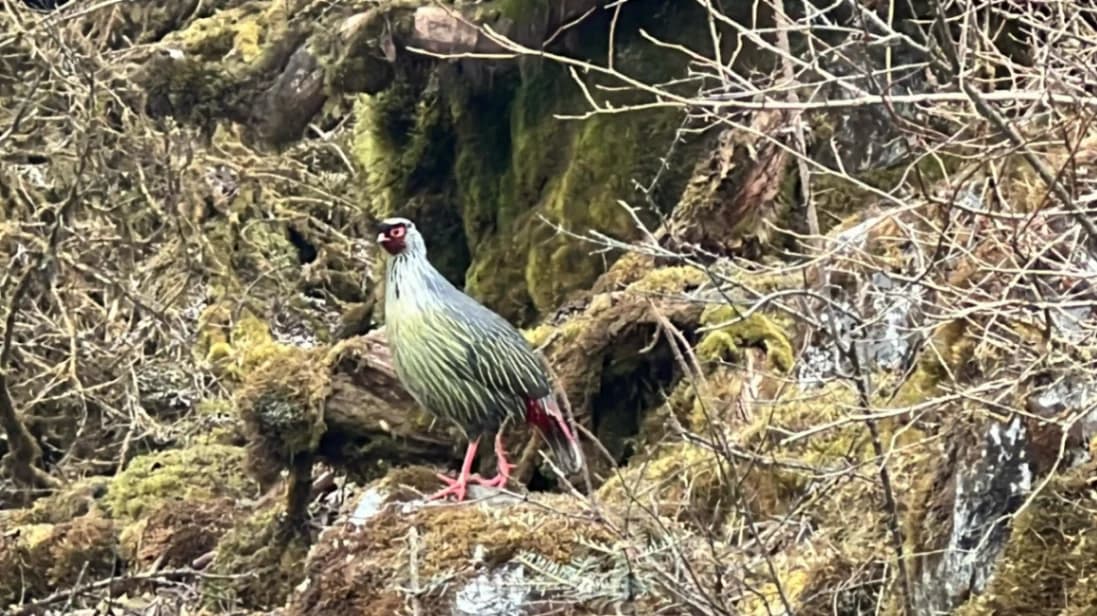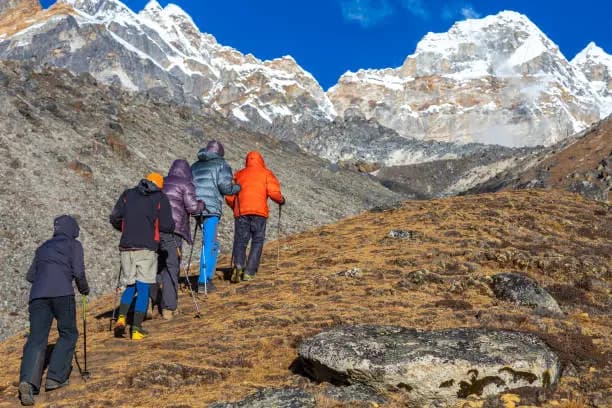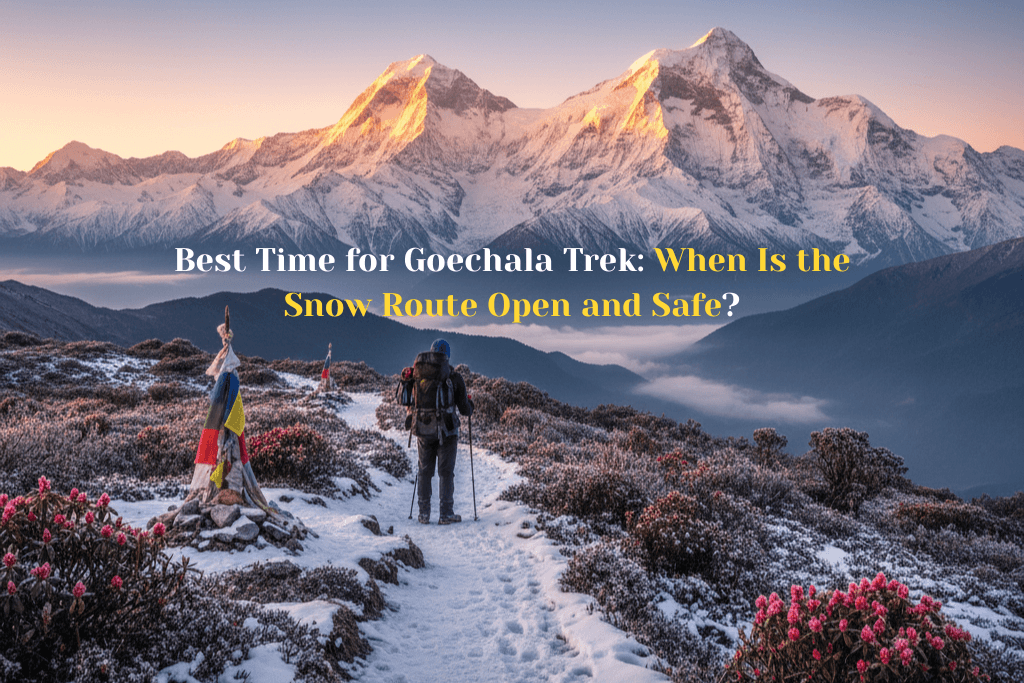The Goechala Trek is demanding but highly rewarding in the Himalayas. It provides one with magnificent views of Kanchenjunga, the world’s third-highest summit.
Trekkers need to be physically fit and adequately prepared for the journey. It demands good fitness levels and careful planning. The Goechala Trek Route is one that traverses different types of landscapes, so it is a one-of-a-kind adventure.
In planning for the Goechala Trek in 2025, it is important to understand the level of difficulty. You should also learn the fitness tips and ideal season to embark on this adventure.
Overview of the Goechala Trek
The Kanchenjunga, the world’s third highest summit, brings trekkers to the Goechala Trek Route. It is one of the most popular treks in the Himalayas. It has breathtaking views and varied landscapes.
Location and Geographic Setting
The Goechala Trek is located in Sikkim, India, in the Himalayas. It is a blend of natural splendor and diverse landscapes. From alpine meadows to dense forests, it is all there to be seen.
This trek has rich and varied flora and fauna. It is ideal for nature enthusiasts and trekkers.
Kanchenjunga Views and Key Attractions
The highlight of the trek is the view of Kanchenjunga. Trekkers view the panorama of this mountain. They view Pandim and Kabru peaks as well.
En route, you will pass through quaint villages. These villages offer insights into the culture and way of life.
Trek Duration and Basic Requirements
The hike takes approximately 10-12 days and is 70 km in distance. You will require good physical condition, proper equipment, and permits.
Understanding the Goechala Trek Difficulty Level
It is understanding the difficulty level of the Goechala Trek that will prepare one accordingly. It is considered moderately tough because of the terrain and elevation involved. There are several challenges that trekkers will face that one must keep in mind.
Physical Challenges and Terrain
The route of the trek is through challenging terrain with steep ascents and descents. You will witness varied landscapes such as lush forests, stony paths, and suspension bridges. It requires good physical fitness, heart fitness, and muscle strength.
Terrain Conditions: There are muddy tracks, stone stairs, and uneven terrain. This is challenging, and even more so during the monsoon.
Altitude Considerations
Altitude plays a significant role in how challenging the trek is. Trekkers need to be aware of the dangers of high altitudes.
Maximum Elevation Points
The summit is approximately 4,940 meters above sea level along Goechala Pass. This elevation may induce illness in certain individuals if they are not properly acclimatized.
Acclimatization Challenges
Acclimatizing to the height is important in order not to suffer from sickness. Trekkers should ascend gradually, allowing bodies to adapt to the increased height.
Difficulty Rating Compared to Other Himalayan Treks
Compared to other Himalayan treks, Goechala is moderately tough. It’s less hard than treks like Kanchenjunga Base Camp but tougher than easier ones like Singalila Ridge.
Detailed Goechala Trek Route Map
Starting the Goechala Trek means knowing its route map well. It’s a journey through the Himalayas, with stunning views and varied landscapes.
Starting Point at Yuksom
The trek starts in Yuksom, a historic town in Sikkim. It’s the beginning of many treks. Yuksom is easy to reach by road, making it a great starting point. The trek begins with a gentle climb through green forests.
Major Campsites and Checkpoints
The trek has many campsites and checkpoints. Each offers unique experiences and amazing views.
Sachen to Tshoka
The first big part is from Sachen to Tshoka. It’s a slow climb through dense forests. Tshoka is a key stop for its beautiful setting.
Dzongri to Thansing
The next big part is from Dzongri to Thansing. This section is tough but offers incredible mountain views.
Lamuney to Goechala Viewpoints
The last part, from Lamuney to the Goechala viewpoints, gives trekkers the best views of Kanchenjunga.
Elevation Profile and Distance Breakdown
The Goechala Trek is about 70 km round trip. It gains a lot of elevation. The highest point is Goechala, at about 4,940 meters.
Knowing the elevation and distance is key for planning the trek.
Best Season to Trek Goechala in 2025
Planning to trek Goechala in 2025? Knowing the best season is key. The Himalayas have changing weather, and picking the right time is important.
Pre-Monsoon Season (April-May)
The pre-monsoon season is great for Goechala Trek. The weather is stable, with clear skies and mild temperatures.
Rhododendron Blooming Period
In April and May, the trails are filled with blooming rhododendrons. This adds vibrant colors to the scenery. It’s a treat for nature lovers and photographers.
Temperature and Visibility Conditions
Daytime temperatures are pleasant, but nights can get chilly. The visibility is excellent, giving stunning views of Kanchenjunga.
Post-Monsoon Season (September-November)
The post-monsoon season is also excellent for Goechala Trek. The trails are fresh, and the air is crisp after the monsoon rains.
Clear Mountain Views
This season offers clear mountain views. It’s perfect for photography and enjoying the scenery.
Festival Season Considerations
This time has local festivals, adding cultural richness to the trek. But, trails might be busier.
Months to Avoid and Why
Months to Avoid: Avoid the monsoon season (June to August) due to heavy rain. It makes trails slippery and increases landslide risks. Also, winter (December to March) is too cold, with snow on trails.
Essential Fitness Preparation for Goechala Trek
Getting ready for the Goechala Trek means more than just showing up. You need to be physically fit and get used to the high altitude. The trek is tough, so you’ll need strength and stamina to make it through.
3-Month Training Plan
A 3-month plan is key to getting ready for the Goechala Trek. It should include cardio, strength training, and hikes. This mix will help you build up your endurance.
Cardiovascular Endurance Building
Being good at cardio is essential for the trek. Running, cycling, or swimming for 30 minutes, three times a week, will boost your heart health.
Strength Training Exercises
Strength training is important for the trek’s tough terrain. Work on exercises that strengthen your legs, core, and upper body. Squats, lunges, and push-ups are good choices.
Practice Hikes with Loaded Backpack
Practice hikes with a heavy backpack are a must. They help you get used to the trek’s demands. Try hikes that last 5-6 hours with a 10-12 kg backpack.
Altitude Acclimatization Strategies
Getting used to high altitudes is vital to avoid sickness. Climb slowly, drink lots of water, and watch how your body reacts. Rest days are also important.
Nutrition and Hydration Preparation
Eating right and staying hydrated are key for a successful trek. Eat a balanced diet with carbs, proteins, and fats. Drink plenty of water before, during, and after the trek.
Complete Goechala Trek Packing List
The Goechala Trek requires careful planning, starting with a detailed packing list. A well-prepared trekker is more likely to have a safe and enjoyable journey on this challenging Himalayan trek.
Clothing and Layering System
A versatile clothing system is key for adapting to changing temperatures and weather. The trick is to wear layers, making it easy to adjust as needed.
Base Layers and Insulation
Base layers should be moisture-wicking and breathable. Insulation layers add warmth. Thermal tops and leggings are must-haves for cold weather.
Outer Shell and Weather Protection
An outer shell that’s waterproof and windproof is essential. Choose jackets and pants with a breathable membrane.
Footwear and Accessories
Trekking boots need to be sturdy, waterproof, and support your ankles. Trekking socks should wick moisture to keep your feet dry.
Essential Trekking Gear and Equipment
Along with clothing, several trekking items are vital for a safe and successful Goechala Trek.
Backpack and Sleeping Gear
A comfortable backpack with a rain cover and a sleeping bag for cold temperatures are essential.
Trekking Poles and Navigation Tools
Trekking poles offer stability on uneven terrain. Navigation tools like a compass and map are critical.
Lighting and Power Banks
Headlamps or torches are needed for nighttime navigation. Power banks keep your devices charged.
Medications and First Aid Kit
A first aid kit should have bandages, antiseptic wipes, pain relievers, and personal medications. Don’t forget altitude sickness medication.
By packing these essentials, trekkers can ensure they’re ready for the Goechala Trek’s challenges.
Permits and Logistics for Goechala Trek
To have a great time on the Goechala Trek, knowing about permits and logistics is key. This trek offers stunning views of the Kanchenjunga. It needs careful planning from the start.
Required Permits and Documentation
Trekkers must get specific permits for the Goechala Trek. You’ll need the Kanchenjunga National Park Permit and the Goechala Trek Permit. These are vital for trekking in protected areas. You can get them through trekking agencies in Yuksom.
-
Kanchenjunga National Park Permit
-
Goechala Trek Permit
-
TIMS (Trekker’s Information Management System) Card
Transportation to Yuksom
Getting to Yuksom, the trek’s start, involves a few steps. Most people fly to Bagdogra/NJP (Nearest Airport) first. Then, they drive to Yuksom.
From Bagdogra/NJP to Gangtok
The trip from Bagdogra/NJP to Gangtok takes 4-5 hours. You can take a taxi or book a private transfer.
From Gangtok to Yuksom
Next, you drive to Yuksom from Gangtok. It’s about 2-3 hours. The drive is beautiful, with great views.
Guide and Porter Arrangements
It’s wise to hire a guide and porter for the trek. Guides share knowledge about the area, culture, and wildlife. Porters help carry your bags, so you can enjoy the trek more.
Day-by-Day Goechala Trek Itinerary
The Goechala Trek is a once-in-a-lifetime adventure. It offers stunning views of the Kanchenjunga range. The trek is structured with campsites and checkpoints, making it accessible for all.
Standard 10-Day Itinerary Breakdown
The 10-day trek is designed for comfort. It allows trekkers to adjust to high altitudes and enjoy the scenery.
Days 1-3: Yuksom to Dzongri
The trek starts in Yuksom. Trekkers follow the Goechala Trek route to Bakkhim and then to Dzongri. This phase gradually increases altitude, helping trekkers adjust.
Days 4-6: Dzongri to Goechala and Back
From Dzongri, trekkers reach Goechala, the trek’s highest point. It offers breathtaking views of the Kanchenjunga. The return to Dzongri is equally beautiful, with plenty of natural beauty to enjoy.
Days 7-10: Return Journey and Buffer Days
The return journey goes back to Yuksom. The plan includes buffer days for any unexpected delays due to weather or health issues.
Alternative Routes and Variations
There are alternative routes for those seeking different experiences. These options cater to various time constraints and preferences.
Shorter 7-Day Itinerary
A 7-day version is available for those with less time. It focuses on the most important parts of the Goechala Trek route.
Extended Version with Side Treks
For a deeper experience, there’s an extended version. It includes side treks to nearby attractions, making the adventure more immersive.
Safety Considerations and Emergency Protocols
For a safe and fun Goechala Trek, knowing health risks and emergency plans is key. The trek’s tough terrain and high altitude need careful planning.
Common Health Risks and Prevention
On the Goechala Trek, trekkers face risks like altitude sickness, hypothermia, and injuries. Knowing these risks helps prevent them.
Acute Mountain Sickness (AMS)
Acute Mountain Sickness (AMS) is a big risk at high altitudes. Symptoms include headaches, nausea, and tiredness. Prevention is about climbing slowly and getting used to the altitude.
Hypothermia and Frostbite
Hypothermia and frostbite are dangers in the cold. Wearing the right clothes and gear helps avoid these. Trekkers should know the signs and take steps to prevent them.
Physical Injuries and Prevention
Physical injuries can happen on the challenging terrain. Wearing the right shoes and using trekking poles can help avoid injuries.
Emergency Evacuation Information
In emergencies, having the right info and resources is vital. This includes knowing how to communicate, the nearest medical places, and helicopter rescue options.
Communication Options
Mobile phone coverage is limited but available at some points. Trekkers should carry a portable charger and power bank.
Nearest Medical Facilities
The closest medical places are in Gangtok or Yuksom. Trekkers should know these locations for emergencies.
Helicopter Rescue Possibilities
Helicopter rescue is an option for severe emergencies. But, it depends on the weather and may cost extra.
Conclusion: Is the Goechala Trek Right for You?
The Goechala Trek is a tough but rewarding journey. It shows off the stunning views of the Kanchenjunga mountain range. Knowing the goechala trek route map and its difficulty helps you prepare.
To tackle the trek, you need good physical shape, to acclimatize well, and the right equipment. If you’re thinking about the Goechala Trek, check if you’re up for it. Look at the trek’s difficulty and what you need to do to stay safe and enjoy it.
With the right prep and attitude, the Goechala Trek can change your life. It offers amazing views and a deep connection with nature. If you’re up for the challenge, the Goechala Trek will leave a lasting mark. Start planning your goechala trek today and get ready to see the Himalayas’ beauty.
FAQ
What is the best time to undertake the Goechala Trek?
The best times for the Goechala Trek are April-May and September-November. These periods offer stable weather and clear views of the mountains.
How difficult is the Goechala Trek?
The Goechala Trek is moderately difficult. It has steep paths and high altitudes. Trekkers need to be ready for these challenges.
What is the maximum elevation reached during the Goechala Trek?
The trek reaches about 4,940 meters (16,207 feet) at the Goechala viewpoint.
Do I need to hire a guide or porter for the Goechala Trek?
Hiring a guide or porter is recommended. They offer local knowledge, help with navigation, and carry your gear.
What are the necessary permits required for the Goechala Trek?
You need a trekking permit and a Sikkim permit for the trek. These can be arranged through a trekking agency or tour operator.
What is the typical itinerary for the Goechala Trek?
The trek lasts about 10-12 days, covering 70 km. It starts and ends in Yuksom, passing through campsites and viewpoints.
How can I prepare for the high altitude of the Goechala Trek?
Acclimatize by gradually increasing elevation. Stay hydrated and know the signs of Acute Mountain Sickness (AMS).
What should I pack for the Goechala Trek?
Pack essential items like layered clothing, sturdy shoes, a backpack, and sleeping bag. Don’t forget personal medications, a first-aid kit, and navigation tools.
What is the Goechala Trek route map?
The route map shows the trek from Yuksom to Goechala and back. It highlights campsites, checkpoints, and scenic spots.
Are there any alternative routes or variations for the Goechala Trek?
Yes, there are shorter 7-day itineraries or longer versions with side treks. These can be tailored to your preferences and schedule.





